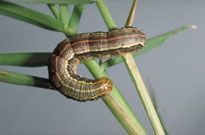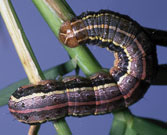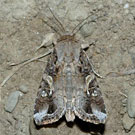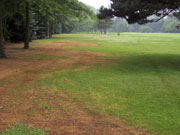home | fall garden | rose garden
Fall Armyworm
Fall armyworm gets its name from its feeding habit. The armyworms will eat everything in an area and once the food supply is exhausted the entire "army" will move to the next available food source. Fall armyworms exist in all states east of the Rocky Mountains. Their diet consists mainly of turfgrasses and small grain crops. Fall armyworms are hard to detect because they migrate to new feeding areas during the night. Female moths will lay up to 100 dome-shaped eggs in masses and cover them with grayish scales. This gives the eggs a fuzzy or moldy appearance. Larvae hatch in 3 to 5 days and feed in clusters. Newly hatched larvae are about 1/16 inch long and light grayish green. Older larvae range in color from light tan, to olive green, to nearly black. A full grown larva will measure 1 1/2 inches long and will have stripes running along its sides. Fall armyworms can be distinguished by a light-colored, inverted Y-shaped marking on the front of its head. As the larvae grow they can consume the equivalent of a large handful of grass, so if there is an infestation they can progressively thin a lawn in several days. Discolored patches in lawns are the first sign of fall armyworm infestation. After 14 days of constant feeding, larvae move into the soil to pupate at a depth of an inch or two. After 8 or 9 days, moths emerge from their cocoon. Both female and male moths look alike, except for the triangular white spot near the extreme tip of the males' wings.
 |
 |
 |
 |
